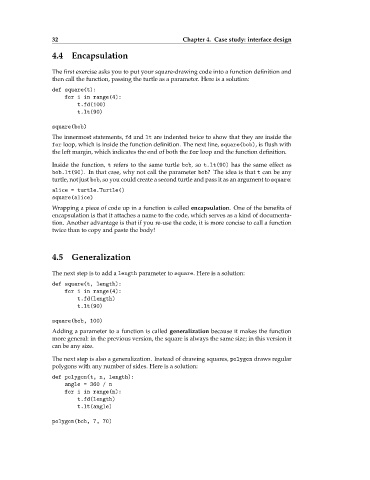Page 54 - thinkpython
P. 54
32 Chapter 4. Case study: interface design
4.4 Encapsulation
The first exercise asks you to put your square-drawing code into a function definition and
then call the function, passing the turtle as a parameter. Here is a solution:
def square(t):
for i in range(4):
t.fd(100)
t.lt(90)
square(bob)
The innermost statements, fd and lt are indented twice to show that they are inside the
for loop, which is inside the function definition. The next line, square(bob) , is flush with
the left margin, which indicates the end of both the for loop and the function definition.
Inside the function, t refers to the same turtle bob, so t.lt(90) has the same effect as
bob.lt(90) . In that case, why not call the parameter bob? The idea is that t can be any
turtle, not just bob, so you could create a second turtle and pass it as an argument to square :
alice = turtle.Turtle()
square(alice)
Wrapping a piece of code up in a function is called encapsulation. One of the benefits of
encapsulation is that it attaches a name to the code, which serves as a kind of documenta-
tion. Another advantage is that if you re-use the code, it is more concise to call a function
twice than to copy and paste the body!
4.5 Generalization
The next step is to add a length parameter to square . Here is a solution:
def square(t, length):
for i in range(4):
t.fd(length)
t.lt(90)
square(bob, 100)
Adding a parameter to a function is called generalization because it makes the function
more general: in the previous version, the square is always the same size; in this version it
can be any size.
The next step is also a generalization. Instead of drawing squares, polygon draws regular
polygons with any number of sides. Here is a solution:
def polygon(t, n, length):
angle = 360 / n
for i in range(n):
t.fd(length)
t.lt(angle)
polygon(bob, 7, 70)

